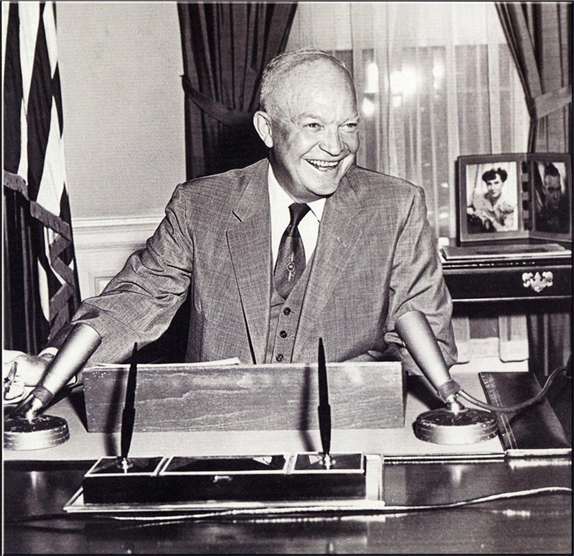 As President Truman’s presidency drew to a close, voters were disappointed with the Democratic Party for the stalemate in the Korean War and for the sweeping wave of McCarthyism. Since his approval rating declined to a meager 23 percent, Truman decided not to run for reelection in 1952. Due to discontent with the Democratic Party, voters elected General Dwight D. Eisenhower over his Democratic opponent, Governor Adlai Stevenson.
As President Truman’s presidency drew to a close, voters were disappointed with the Democratic Party for the stalemate in the Korean War and for the sweeping wave of McCarthyism. Since his approval rating declined to a meager 23 percent, Truman decided not to run for reelection in 1952. Due to discontent with the Democratic Party, voters elected General Dwight D. Eisenhower over his Democratic opponent, Governor Adlai Stevenson.
As Eisenhower entered the presidency, and his running mate, Richard Nixon, took office as Vice President, it became clear that the new administration would take a new approach to government. Eisenhower’s “dynamic conservatism,” or “Modern Republicanism,” was a middle-of-the-road approach involving fiscal conservatism and social liberalism. Among his accomplishments in the domestic arena were balancing the budget, cutting taxes, and raising the minimum wage. He also extended Social Security and unemployment benefits, increased funding for public housing, and played a part in the formation of the Department of Health, Education, and Welfare.
The fiscal responsibility and social reform of the Eisenhower administration ushered the 
Eisenhower’s “reign” was not absolutely successful. Despite the relative comfort of the middle class, the urban poor witnessed little improvement in quality of life, partly because of the fact that middle and upper class Americans flocked to the suburbs, leaving cities unbalanced and poor. Furthermore, Eisenhower did little to promote civil rights. In the Cold War, Eisenhower focused on the development of nuclear weapons, following a policy of brinkmanship, and he issued the Eisenhower Doctrine in 1957, pledging to defend the Middle East against attacks from communist countries. His failure to focus on a space program, however, provoked fears that the Soviet Union would overtake the
Wednesday, March 24, 2010
Eisenhower's Presidency
Subscribe to:
Post Comments (Atom)
I like how your summary of Eisenhower's presidency covered important issues like the economy and foreign policy at the time, which were both positively and negatively affected by Eisenhower's policies. Good job - this was a very objective description of Eisenhower's reign.
ReplyDeleteLiked how you covered both the good and bad times of Eisenhower's reign, as you put it. There was a lot of information and there was a good organization. You placed the second picture really nicely. I think I owe you 75 cents. Good post!
ReplyDeleteVery nice posting, a lot of good information and good pictures. Awesome job!
ReplyDeleteIt seems after Truman was president, Eisenhower was very welcomed. I learned a lot, good post.
ReplyDeletegood job, you provided a detailed summary of Eisenhower's presidency.
ReplyDeleteThis comment has been removed by the author.
ReplyDelete